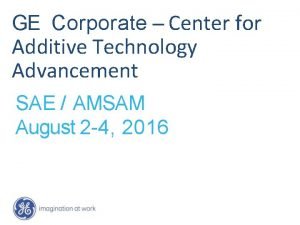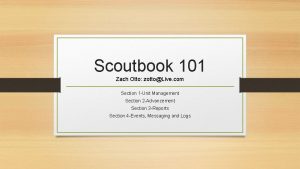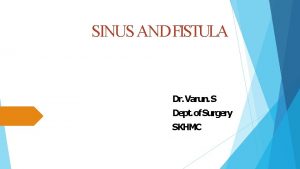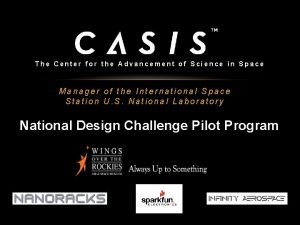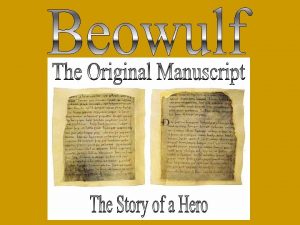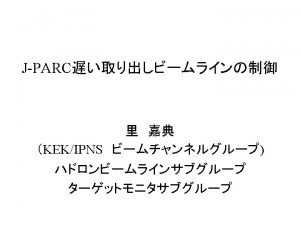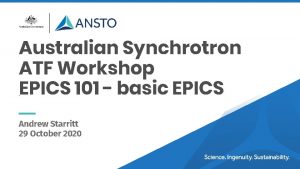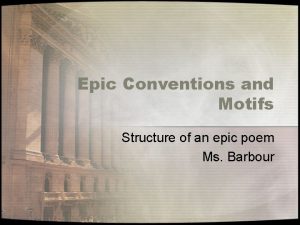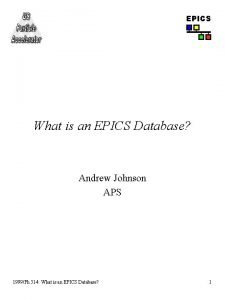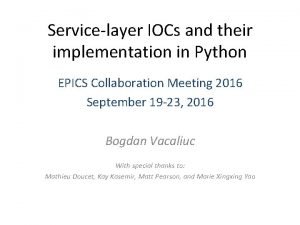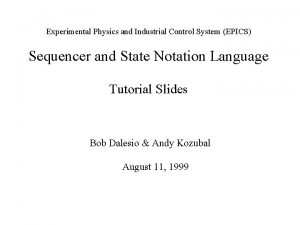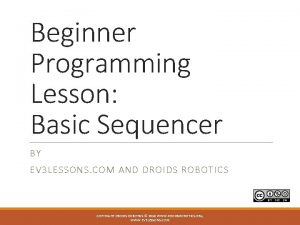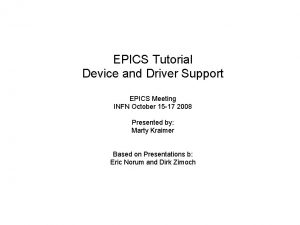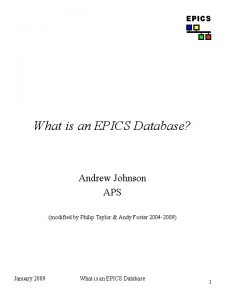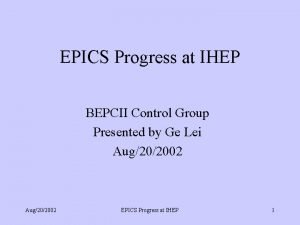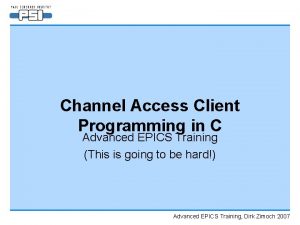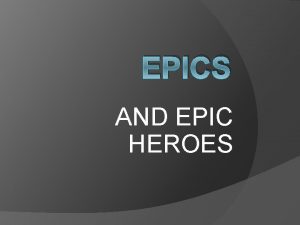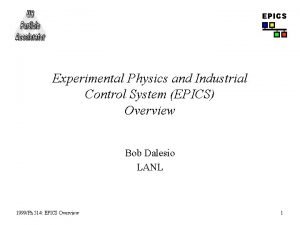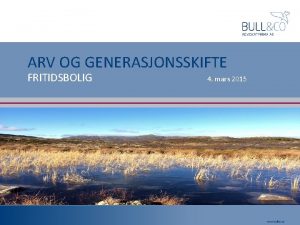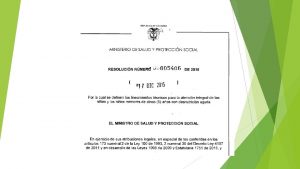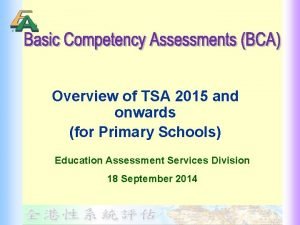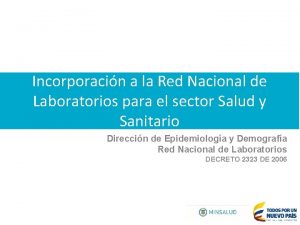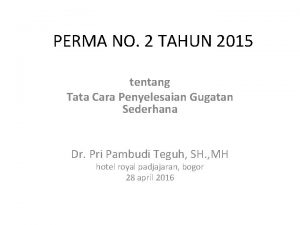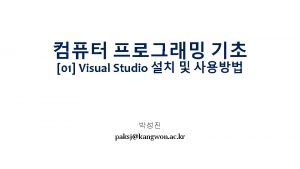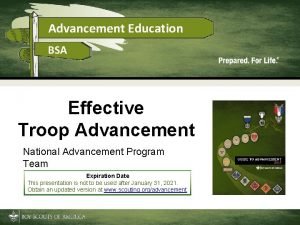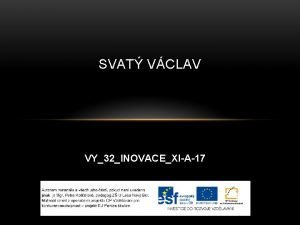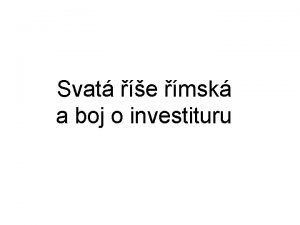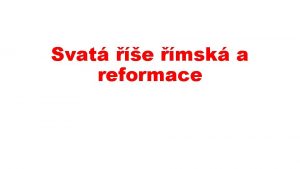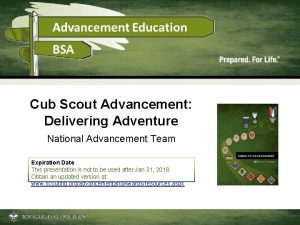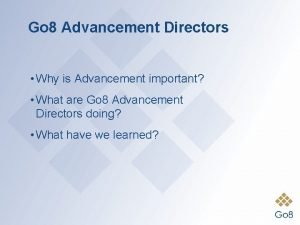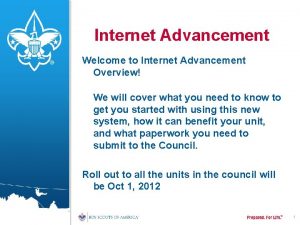EPICS SVAT St Vincents Advancement Team Spring 2015









































































- Slides: 73

EPICS - SVAT St. Vincent’s Advancement Team Spring 2015 Mid-Semester Design Review 1

Iron Man Project 2

Foot Drop ● Courtney Smith, Design Lead o Junior - Agricultural Engineering, Machine Systems ● Jennie Boehm o Junior - Mechanical Engineering ● Alex Mount o Sophomore - Electrical Engineering 3

SWARM- Sensors for Walking and Running Movement ● Sara Harman, Design Lead ○ Junior- Multidisciplinary Engineering ● Hun Chan (Bryan) Lee ○ Junior- Mechanical Engineering ● Daniel Seach ○ Freshman- First Year Engineering 4

Project History Started Spring 2014 Shortfalls in current design included ankle mobility and responsiveness Two sides: Mechanical and Electrical (SWARM) Fall 2014 Foot Drop project started, mechanical ankle design transferred to senior design team Current Foot Drop team continuing Combining expertise of two teams to move both projects forward 5

Iron Man Semester Timeline 6

Foot Drop Condition Desire for Greater Mobility Project Motivation Lack of Effective Market Solutions 7

Problem Definition Problem Statement ● Individuals with Foot Drop are faced with the difficulty of moving about freely due to an inability to lift the foot and a lack of effective assistive solutions on the market. Goals ● Create a normal walking gait ● Allow physical activity ● Create upward tension for toe-off 8

Past Deliverable ● Characteristics o o o Combination of Ideas from past designs Provides more dorsal tension than any previous design Reduced friction on side of foot ● Features to address o o Slightly bulky and rigid Tension is lost over time from the elastic Improved comfort Shoe versatility 9

Project Partner Experience Comments on Team “I found all of the team members to be well-spoken and able to articulate ideas clearly and intelligently. They were also very good at listening and picking up even the smallest of details from our discussions. ” Comments on Brace With the final design, I am able to run and play tennis (albeit at a lower level). I am also able to walk without a modified gait which not only greatly increases my endurance throughout the day, but it also helps mentally-I no longer feel like I have a handicap. Prior to this brace, running, hiking, playing tennis or other physical activities could not be considered due to risk of falling and injury. Now, I am able to participate in those activities without those risks. This brace has returned my life back to where it was prior to my injury. 10

Semester Timeline 11

Current Design Discoveries ● Toe Lift ● Ankle support ● Point of attachment ● Degree of tension ● Hot spots on foot 12

Next steps/Future Design ● Continue improving the sock design ● Quantitatively measure the success of the past delivered brace ● Combine with SWARM for more testing 13

Sensors for Walking and Running Movement 14

SWARM Project Introduction • Background- current commercially available prosthetics do not respond to users movement • Goal of Project- develop prosthetic foot that responds to the user • Goal for semester- improve a system of sensors, gather and analyze data + + 15

Project Introduction-- Components Measurement / purpose Component Acceleration and rotational velocity Inertial Measurement Unit (IMU) Muscle Activity Electromyography Sensor (EMG) Pressure Force Sensor Communication x. Bee radio module Memory SD card and shield Coordination Arduino Uno Computer User Interface Processing, MATLAB 16

Project Introduction- Previous Work ● Spring 2014 ○ Project initiation ○ EMG ○ IMU ○ Arduino Lily: Wearable electronics ● Fall 2014 ○ EMG shield ○ Force Sensors ○ x. Bee ○ Processing 17

Semester Plan ○ Continuously improve user interface and adapt to current state of project ○ Collect and analyze data with Foot Drop project 18

Semester Progress ○ Continuously improve user interface and adapt to current state of project ○ Collect and analyze data with Foot Drop project 19

Semester Progress-- IMU visualization Progress • Processed IMU data with MATLAB Goals • Real- time graph of IMU data 20

Semester Progress-- Processing Focuses this Semester • improving graph clarity • secondary force image • multiple windows • add IMU visualization (in progress) • save force and imu data to text file 21

The XBee’s are wireless transceivers that communicate over a network with the aid of XCTU software 22

Semester Progress-- wireless Wks 1 -3 Research XBee wireless kit purchased Battery purchased Wks 4 -5 Configuration Wks 5 -6 Code modification Wk 6 Transmission of Force and IMU data Battery implemented Future Solution to freeze issue 23

Semester Progress • • Research SD card, purchasing Beginning of design process for 3 D printed casing Research multiple IMU issue Multiplexer allows for simultaneous usages of i 2 c communication • Added sensors to Foot Drop Brace 24

Semester Plan • • Fix x. Bee Freeze issue Implement IMU multiplexer Assemble knee component Gather EMG data Design and 3 D print casing Save processing graphs and create GUI Use SD card to save data internally 25

Semester Plan ● Use to quantify benefits of other assistive devices ● Use in responsive prosthetic 26

Test Data Brace Unaided Sock Prototype 27

28

29

30

Conclusions ● Brace increases walking speed over 30% and gives sharper, faster movements ● Un-assisted walking results in toe-heel gait ● Brace and prototype both result in heel-toe gait ● More analysis needed ● Next test should include other foot for a baseline of normal gait 31

Questions? 32

Hippotherapy Patrick Carmody Bradley Barnhart 33

Past Work 34

Current Plans • • 5 Possible Phases 3 initial designs 2 future designs Priority is based on information needed from stakeholders and importance to the completion of the project • Contacts at St. Vincent • Goal: To make the hippotherapy project more closely resemble a finished project in the aspect of safety, quality of components and overall look and feel. 35

Phase 1: Handles • 3 Sets of handles for different uses • Back will have 45ᵒ handles made of either metal or PVC • Front will have straight vertical handles of same material • From will have wagon type handle 36

Phase 2: Step Up System • Two step system integrated into the frame • Possible change to priority list after further investigations 37

Phase 3: Axle and Wheel Fabrication • Original wheel and axle construction was not sound • Wheel hubs • Fabrication of wheels 38

Phase 4: Design Delivery • Find an organization with a need for the design • Meet with the organization to discuss additional improvements and modifications 39

Phase 5: Additional Improvements • Based on feedback, but we have some suggestions • Supportive resistance bands to vary difficulty • Horse head 40

AMC Assistive Technology Team 41

The Project Team • Stephanie Klunk, Project Leader o Junior – Biomedical Engineering • Sean Godfrey o Senior – Biomedical Engineering • Anneliese Smith o Junior – Industrial Engineering • Kelsey Wasilczuk o Junior– Biomedical Engineering • Joey Shin o Freshman - Engineering • Matt Derdak o Freshman - Engineering 42

Client Background • • Client: Two year old boy with AMC Background Arthrogryposis Multiplex Congenita Constant tightness of muscles (contractures) Shortening of muscles and tendons Can affect legs, arms, and hands Challenge: Client has very limited control of hands, arms, feet, and legs due to his AMC. This prevents him from completing tasks such as eating, writing, walking, etc, independently. 43

Current Available Solutions • • Devices that are entirely automated Not Cost Effective - $7, 000 - $10, 000 Devices do not encourage independence Example – Mealtime Partner $8, 545 44

Project Goals • Overall Project Objective • To design assistive technology for our client to help him eat, drink, write, move, and play. • Current Semester Objective • The top priority is to develop a device that allows our client to eat without the aid of his parents during mealtime. Once this device is delivered we will begin developing additional assistive technology. 45

Design Specifications • User Friendly • Portable • Child-friendly (nontoxic material, not restrictive, etc. ) • Adjustable • Entertaining • Easy to Clean 46

Conceptual Designs • Incline Roller Track Design – Allows client to push arm up along track using his torso • Seatbelt Design – Attaches from back of chair to client’s wrist • Automated Actuator Design – Moves spoon up and down using a motor • Richie Parker Design – Rotating rod with magnetic spoon Richie Parker Eating Device Video 47

Richie Parker Design Prototype • Client scoops food manually with utensil in his mouth • Spoon attaches magnetically to the top of the rod • Client rotates rod with cheek/shoulder and eats 48

Current Design Challenges • • • Magnet Strength Utensil Attachment Adjustability Rotation Options Utensil Design 49

Questions? 50

Braille e. Reader Kyle Mc. Nulty Daniel Delacruz Daniel Darcy Aditya Goodala Alex Lee Dustin Soliday Jessica Place 51

Project Motivation • In the United States, over 6. 6 million reported to have a visual disability in 2012 • Of the 1. 3 million people who are legally blind in the United States, less than 10% read Braille. • Over 70% of adult who are blind are unemployed • As many as 50% of high school students who are blind drop out of school. 52

Problem • Currently only single-line Braille readers on commercial market • Prices range from $2, 500 to $15, 000 on average • Single-line devices can only display 40 – 80 characters at a time o Requires constant refreshing of device • Research teams all over the world have explored a variety of solutions. o Many projects found a solution but were never able to commercialize it. o Federal funding for research projects on multi-line readers has shrunk. 53

Solution • GOAL: To develop an electronic, multiple-line, refreshable Braille display capable of displaying 800 or more braille characters 54

User Needs and Specifications • Battery operated (DC power) • Unit cost (commercialized) under $3, 000 o Per cell cost less than $1. 00 • Refresh rate of 320 words per minute • Lifetime: 107 cycles • Wireless connectivity • Operational regardless of orientation o Does not use the force of gravity to lower pins o Two full page refreshes per minute (<< 1 Hz) • Easily repairable o Each 8 pin cell is operationally independent o Can be removed and replaced with ease 55

Device Specifications Parameter Typical Value Our Design Device width 11. 3 inches 12 inches Device height 3. 2 inches 12 inches Device character capacity 40 Characters 800 Characters Braille Dot Base Diameter 1. 5 mm 1. 59 mm Dot Height (assuming no depression from user’s finger) 0. 5 mm 2 mm Height of 8 -Pin Braille cell 13. 25 mm 12. 7 mm Width of 8 -Pin Braille cell 6. 35 mm Raised pin holding force 0. 294 N ~0. 5 N 56

Methods of Pin Actuation • • • Piezoelectric Electromagnetic Wedges Hydraulics Pneumatics Electroactive Polymers 57

Device Components • There are three primary aspects of our design: o Mechanism to raise a pin and engage latch (Actuation) o Mechanism to disengage latch and release pin (Release) o Method of electronically control 6, 400 solenoids simultaneously. (Electronic Control) • Electromagnetics for both Actuation and Release mechanisms • Multiplexed matrix display for method of Electronic Control 58

Actuation Mechanism: Solenoids • Electromagnetically actuated pins o Two solenoids per pin o Eights pin per cell • Mechanically latching pins o Each solenoid only requires a pulse to move it into the up position, before it is mechanically locked in the up position. o Drastically reduces power consumption and heat generation • 20 line matrix, with 40 cells per line 59

Advantages: Solenoid Actuation • Current pulsing drastically reduces power consumption and heat generation • Overall weight reduction • Coils have no polarity, current can be driven in either direction. 60

Solenoid Manufacturing 61

Mechanism Designs 62

Actuation Mechanism • Eliminates the need for any permanent magnets • Dual-coil solenoid to provide actuation in two directions (up & down) • Relatively simple to implement at 1 x scale 63

Mechanism Operation Center of Gravity Video 64

Method of Electronic Control • Entire device is not driven at one time o Instead, sub-units of the display are driven one at a time • The display is driven at such high speeds that it appears to be continuously active • The 6, 400 solenoids will be connected in a matrix of rows and columns o +5 V pins of each solenoid in a column will be electrically connected o GND of each solenoid in a row will be connected. 65

Multiplexed Display • To drive an individual pin in the device: o Apply ± 5 V to the column location of the pin o Ground the row location for that pin. • Braille characters will be set one cell at a time, from the top of the page to the bottom right. • Each solenoid will receive around a 50 ms current pulse to move it between the up and down position. 66

User Interface Design • Forward thinking approach to the overall project • Interaction Design o Simplify use o Improve user experience o Intuitive and natural 67

User Interface: Controls Light green: selection buttons Brown: page refresh Pink: navigation Tan: keyboard Red: Dual app slider Dark green: navigation toggle Blue: cursor movement 68

User Interface: Display Date and time Battery indicator If in the menu for the writing app, first item is new file Five menu options, each 3 lines tall 20 lines by 40 cells In menu, bottom line shows the folder title In dual apps, bottom line shows cursor position and navigation state 69

Other Notes Light blue line: Valid locations for hubs, switches, rockers, etc. Trackball, touchpad, or track pad Perkins keyboard to be used for complex chorded commands Square: Menu Up/down: Move a line Over: Move a page Circle: Move a paragraph 70

Issues • Finding additional target users to test our device. • Relatively large current required to drive solenoids. • Magnetically induced coupling of adjacent solenoid coils. • Manufacturing at 1 X scale requires extremely precise 3 D printers. 71

Future Plans • Test device according to the following criteria: o Robustness o Maximum refresh speed o Minimum operating voltage • Program an advanced user interface o Converting from Kindle or i. Pad e. Book file to a file that can be displayed on the device. • Display graphics using braille pins • Create a device that makes computer programming easier for the blind 72

We welcome any Questions, Comments, or Recommendations 73
 Snug house bug house
Snug house bug house Kdo je svat
Kdo je svat Kdo je svat
Kdo je svat Spring break 2015
Spring break 2015 Spring in months
Spring in months Four seasons korean movie
Four seasons korean movie Insall salvati ratio
Insall salvati ratio Center for additive technology advancement
Center for additive technology advancement Holistic advancement meaning
Holistic advancement meaning Daf yomi advancement forum
Daf yomi advancement forum Zeenat antibiotics
Zeenat antibiotics Advancement office structure
Advancement office structure Scoutbook advancement sync
Scoutbook advancement sync Uf advancement
Uf advancement State bank of india canada
State bank of india canada Goodsall rule
Goodsall rule Dental hygienist advancement opportunities
Dental hygienist advancement opportunities Office for the advancement of telehealth
Office for the advancement of telehealth Pharmacy advancement initiative
Pharmacy advancement initiative R-colored vowels
R-colored vowels Advancement in medicine
Advancement in medicine Center for the advancement of science in space
Center for the advancement of science in space Association for the advancement of medical instrumentation
Association for the advancement of medical instrumentation Holistic advancement meaning
Holistic advancement meaning National technology transfer
National technology transfer Professional advancement in nursing
Professional advancement in nursing Important facts about beowulf
Important facts about beowulf Epics channel access
Epics channel access Which one is the longest epic of the world
Which one is the longest epic of the world Epics calc record
Epics calc record A theme is normally shorter than a motif.
A theme is normally shorter than a motif. Css boy
Css boy Epics database
Epics database Pericles and the bull
Pericles and the bull Epics qt
Epics qt Python epics
Python epics Epics sequencer
Epics sequencer Epics sequencer
Epics sequencer Definition
Definition Famous poems about heroes
Famous poems about heroes Epics tutorial
Epics tutorial Epics calc record
Epics calc record Epics calc
Epics calc Epics caget
Epics caget Epic example
Epic example Epics ioc
Epics ioc Epics channel access
Epics channel access What is epic
What is epic Epics control system
Epics control system Epics 7
Epics 7 Epics channel access
Epics channel access Team spirit becomes team infatuation
Team spirit becomes team infatuation Team spirit becomes team infatuation
Team spirit becomes team infatuation The white team cheers for the blue team, just like
The white team cheers for the blue team, just like 2015 honda fit turbo kit
2015 honda fit turbo kit Enem 2015
Enem 2015 Leedy and ormrod
Leedy and ormrod Sameieavtale hytte
Sameieavtale hytte Hsc hospitality exam
Hsc hospitality exam Ilsvrc
Ilsvrc 5406 de 2015
5406 de 2015 Pearson 2015
Pearson 2015 Tsa 2015
Tsa 2015 Red de laboratorios nacionales
Red de laboratorios nacionales 18 / 22
18 / 22 Saasta astro quiz
Saasta astro quiz Normas apa 2015
Normas apa 2015 State government entities certified agreement 2020
State government entities certified agreement 2020 Perma 2 2015
Perma 2 2015 Visual basic express 2017
Visual basic express 2017 June 2015 flacs exam answers
June 2015 flacs exam answers Sosfs 2015:8
Sosfs 2015:8 Dovitinib
Dovitinib Forrester identity governance
Forrester identity governance







